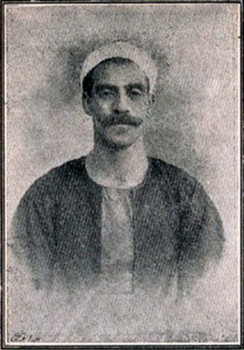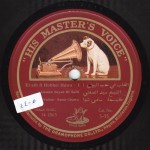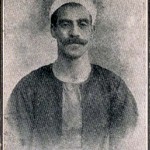The Arab Music Archiving and Research foundation (AMAR), in collaboration with the Sharjah Art Foundation (SAF), presents “Min al-Tārīkh”.
Dear listeners,
Welcome to a new episode of “Min al-Tārīkh”.
Today, we will resume our discussion about Sheikh Sayyid al-Ṣaftī with Prof. Frédéric Lagrange.
Sheikh Sayyid al-Ṣaftī, just like Sheikh Yūsuf al-Manyalāwī, is among those munshid and muqri’ who specialized in performing the religious repertoire at a young age, then gradually shifted to takht singing. There was no barrier between these two arts and it was possible for an artist to specialize in one of these styles. He is an example of those early 20th century munshid whose final choice was mundane singing.
“Duniā gharūra”.
Indeed.
Concerning the history of this shift, i.e. choosing, for good, mundane singing and takht singing with instrumentalists, it is difficult to believe the sources we mentioned in the beginning, i.e. Adham al-Jundī and Aḥmad al-Jundī who both claimed that Sheikh Sayyid al-Ṣaftī went on singing in this inshad style up to the early years of the 20th century, and only shifted to takht singing starting 1905. As we mentioned earlier, the Gramophone/Zonophone archives confirm that Sheikh Sayyid al-Ṣaftī belongs to the first group of Egyptian muṭrib who participated in the adventure of commercial recording, when commercial recording was still an adventure.
I assure you that he had recorded cylinder records before that. We have them…
(♩)
Here is another riddle concerning his personal life. The movie “Bamba Kashshar” produced by Ḥasan al-Imām in the 1960s and set around the World War 1 period, that relates the life of ‘ālima Bamba Kashshar, features Sayyid al-Ṣaftī as her husband, and shows how much he hesitated before removing the jubbah and the caftan and wearing the Afandī costume. This information is of course questionable as the old sources do not mention that Sayyid al-Ṣaftī and Bamba Kashshar were married. Still, where did this story come from? Was it repeated in the musical milieu until it reached Ḥasan al-Imām or the screenwriters who used it? Did they come up with the whole story and used a name among the names famous at the beginning of the century? …Yet a less famous name that would create less confusion…
The drama process, Sir.
Sayyid al-Ṣaftī may have been married to Bamba Kashshar … But this Bamba Kashshar did not record anything.
Another question, are Bamba Kashshar and Bamba the ‘ūdist the same person? We have discussed this in a previous episode of this show dedicated to ‘ālima.
Do we have more recent photos of Sayyid al-Ṣaftī than those taken in the 1920s?
I do not think so. On the other hand, I think there is only one photo: the one of the man with the very long neck in the Gramophone 1914 catalogue. All other photos of Sheikh Sayyid al-Ṣaftī seem to be the same photo, sometimes larger and sometimes with a different frame. The man in this picture seems to be between 30 and 40 years’ old, which is logical since the photo was probably taken in 1895-6-7.
Let us go back to comparing the proportions of the different styles Sayyid al-Ṣaftī interpreted in his recordings:
We have mentioned the muwashshaḥ;
He did not interpret a large number of qaṣīda mursala and I think that he recorded none;
Whereas the qaṣīda ‘ala al-waḥda are more or less the same ones he recorded, once, with: Gramophone; Odeon; Baidaphon; Polyphon; and finally Columbia. The titles of the qaṣīda are always the same. There is “Inna wagdī kulla yōmin fī izdiyād”, “Tadhallal li-man tahwa”, and “Yā malīḥ al-lamā” that is yet another riddle.
A great riddle indeed.
A great riddle because the late recordings of “Yā malīḥ al-lamā” are very similar to the version of Abū al-‘Ilā Muḥammad, knowing that the latter was inclined to composing qaṣīda, and that he represents one phase within the evolution of the qaṣīda ‘ala al-waḥda towards setting the melody in some of his recordings v/s full improvisation in other recordings. In our opinion, Sayyid al-Ṣaftī imitates Sheikh Abū al-‘Ilā Muḥammad in his recording of “Yā malīḥ al-lamā”, especially that he also recorded qaṣīda “Ghayrī ‘ala al-silwān qādir” that he also interpreted exactly like Sheikh Abū al-‘Ilā Muḥammad. So, as such, he is seen as an imitator, just like Umm Kulthūm, Fatḥiyya Aḥmad, or Munīra al-Mahdiyya, among others…. in their early recordings. Abū al-‘Ilā’s version is the original one, and the others performed it exactly as he recorded it. Yet, “Yā malīḥ al-lumā” was recorded by Gramophone in 1908, i.e. before Abū al-‘Ilā Muḥammad’s recording made in 1912. So, who imitated whom? Of course, Sheikh Abū al-‘Ilā Muḥammad may have performed this qaṣīda live, years before the 1912 Gramophone recording. So Sheikh Sayyid al-Ṣaftī may have heard him interpreting it and decided to perform it. We will never either solve or confirm this riddle…
“Bi-bint shafā”
(♩)
On the other hand, there was surely some kind of relation between Sheikh Abū al-‘Ilā Muḥammad and Sheikh Sayyid al-Ṣaftī: they either appreciated each other, or, at least, Sheikh Sayyid al-Ṣaftī appreciated Abū al-‘Ilā Muḥammad.
Yes.
He also interpreted “A-lā fī sabīl al-lāh” –the title on the sleeve is “Anā fī sabīl al-lāh” (I am for the cause of Allah)
Which is true… he was indeed “fī sabīl al-lāh” (for the cause of Allah)
Indeed. …Shall we listen to….
I would like us to play “Inna wagdī kulla yōmin fī izdiyād” that I like a lot… I do not mean that we will not also listen to another one…
First, the lyrics of “Inna wagdī kulla yōmin fī izdiyād” are beautiful. Secondly, those who know by heart all the qaṣīda interpreted by Sheikh Salāma Ḥigāzī may remember that in the disc of “Badru ḥusnin lāḥa lī” followed by qaṣīda “Shakwitī fī al-ḥubb ‘unwān al-rashād”, he repeats this verse in this strange qaṣīda “Shakwitī fī al-ḥubb ‘unwān al-rashād” where he starts to the ṣabā then modulates to the bayyātī, maybe before the end of the second hemistich of the verse, i.e. a quasi instantaneous modulation. We can compare Salāma Ḥigāzī’s performance of this beautiful verse with the full qaṣīda –in fact, muṭrib select verses, they do not sing qaṣīda in full as they were written.
We will listen to it in the voice of Sheikh Sayyid al-Ṣaftī, then you will choose the qaṣīda you prefer.
Both recorded it ‘ala al-waḥda.
Sayyid al-Ṣaftī started it to the bayyātī with the ‘awādhil melody.
Sheikh Salāma Ḥigāzī had signed a sponsorship contract with Odeon and made one recording of this qaṣīda with them, whereas Sayyid al-Ṣaftī had no sponsorship contract with anybody and recorded it with several companies.
We will also listen to the Odeon recording because it was made with the same takht –takht Odeon with Ḥāj Sayyid al-Suwaysī (‘ūd), ‘Abd al-‘Azīz Afandī al-Qabbānī (qānūn), ‘Alī ‘Abduh Ṣāliḥ (nāy)– that plays in both.
(♩)
Dear listeners,
We have reached the end of today’s episode of “Min al-Tārīkh” dedicated to Sheikh Sayyid al-Ṣaftī.
We thank Prof. Frédéric Lagrange.
We will meet again in a new episode to resume our discussion about Sheikh Sayyid al-Ṣaftī.
“Min al-Tārīkh” is brought to you by Mustafa Said.
- 221 – Zakariyya Ahmed – 12 (1/9/2022)
- 220 – Zakariyya Ahmed – 11 (1/9/2022)
- 219 – Zakariyya Ahmed – 10 (11/25/2021)
- 218 – Zakariyya Ahmed – 9 (10/26/2021)
- 217 – Zakariyya Ahmed – 8 (9/24/2021)
- 216 – Zakariyya Ahmed – 7 (9/4/2021)
- 215 – Zakariyya Ahmed – 6 (8/28/2021)
- 214 – Zakariyya Ahmed – 5 (8/6/2021)
- 213 – Zakariyya Ahmed – 4 (6/26/2021)
- 212 – Zakariyya Ahmed – 3 (5/27/2021)
- 211 – Zakariyya Ahmed – 2 (5/1/2021)
- 210 – Zakariyya Ahmed – 1 (4/28/2021)
- 209 – W-al-Lāhi lā astaṭī‘u ṣaddak 2 (4/6/2017)
- 208 – W-al-Lāhi lā astaṭī‘u ṣaddak 1 (3/30/2017)
- 207 – Bashraf qarah baṭāq 7 (3/23/2017)



